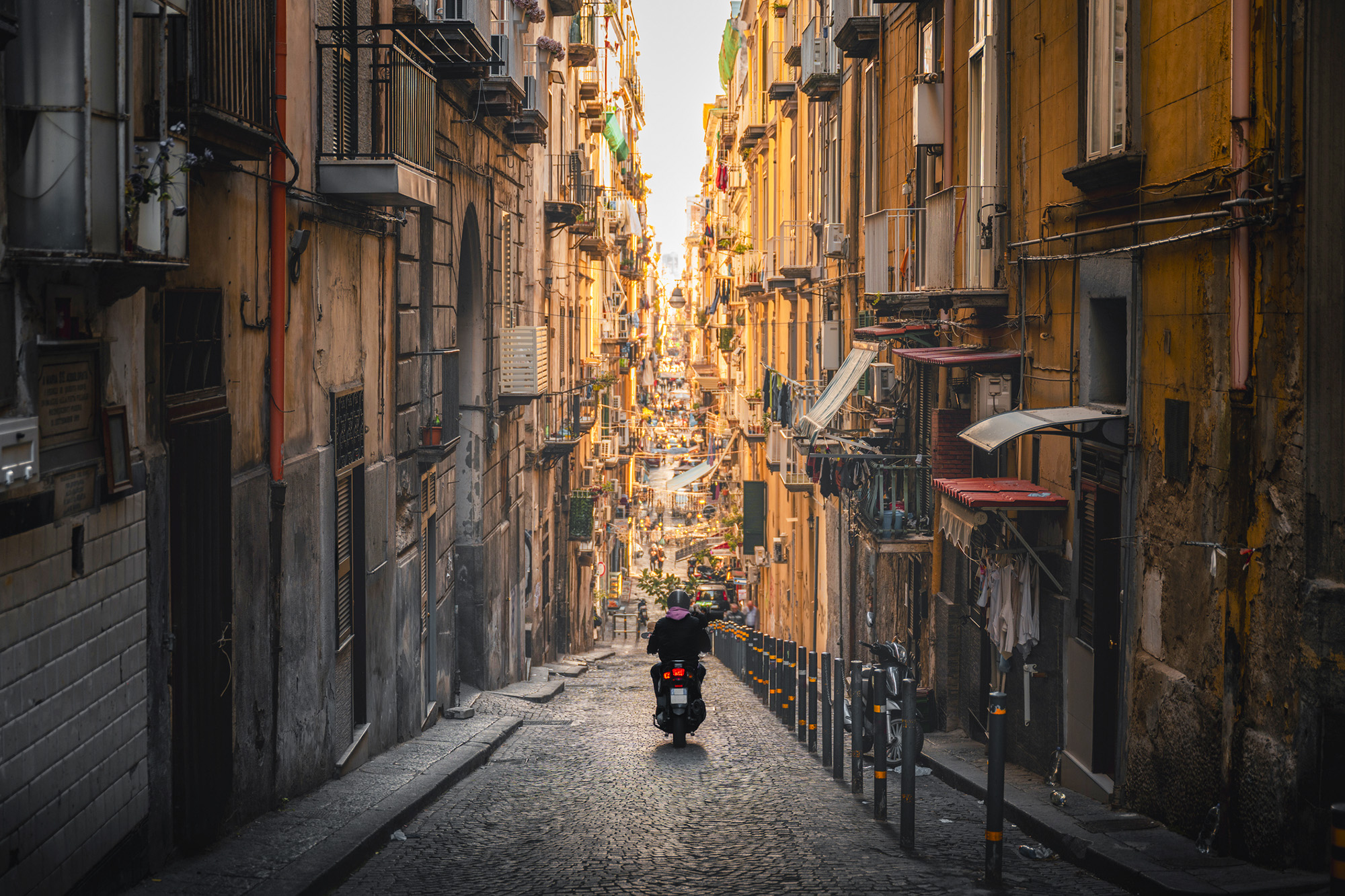Imagine chaos, in all the best ways possible. Streets packed with honking cars, laneways lined with busy walkers and hawkers, plus little Vespas and other scooters, winding through it all. On the left, maybe an argument, full-Italian style, voices raised and arms akimbo. On the right, a slightly impatient queue for the best pizza you can imagine. The aroma of the dough, sauce, and cheese in the wood-fired oven wafts over the whole scene.
Arrival
Naples Capodichino International Airport (NAP) is very close to the heart of the city. You’ll often see and hear big jet planes either taking off or landing as you explore around the urban core. It’s just one more element in the sensory overload that is absolutely typical of a visit here.A major destination for low-cost carriers like EasyJet and Ryanair, a number of national flag bearers also land here from European hubs like Athens, Amsterdam, Munich, and Paris. But if you fly in the warmer months, you may be able to catch a nonstop from North America, with seasonal, direct flights connecting NAP with cities like Chicago, Philadelphia, New York, Montreal, and Atlanta.
Once you arrive, getting into town should be a fairly fast process. A public bus (called Alibus) will take you to the Central Station in about 15 minutes—or, for the port, about 35 minutes. A one-way ticket to the station is five euros. Ride-share services aren’t common. If you decide to take a taxi, make sure to arrange a predetermined price that seems fair before getting into the back of the cab.

Morning
Napoli is best experienced at street level—although I’d advise you to encounter it in fairly measured doses. If you’ve taken the Alibus to the Napoli Centrale train station, just start walking. Each block on your route will be a whole opera in itself. Comedy, not tragedy—hustle and bustle and interesting narratives, no matter where you look.Work your way to the southwest, more or less tracing the outline of the Gulf of Naples. Striding along the major thoroughfare of Corso Umberto I will take you about 45 minutes to reach the Royal Palace of Naples.

Just before you arrive, make a brief stop at the Galleria Umberto I to gaze up at the glassy domes. Named (like the street it sits on) for King Umberto, the reigning monarch in Italy at the time of its construction, this shopping complex was completed in 1890. It was a key part of the “risanamento,” a large-scale rebuilding project that literally means “make healthy again.”
Today, it’s part of the historic center of Naples, a recognized UNESCO World Heritage Site. Spending a few minutes walking inside will lift your spirits and banish any fatigue or malaise left over from your long flight. Many days, a bright Southern Italian sun spills down through the vaulted glass, over the shops and cafes inside.
Now might be a good time to grab a quick morning snack, maybe just a double espresso consumed, Italian-style, while standing at the bar and perhaps paired with sfogliatella, a typical, flaky breakfast pastry, often filled with ricotta.
Afterward, exit the Galleria and take note of San Carlo Theatre, across the road, opened back in 1737.
“This is the oldest continuously operated opera house in the world,” a guide told me on a recent visit. “I have good memories of going there with my father, to see Pavarotti.”

Then, it’s just a couple of blocks to the Royal Palace of Naples. A potential problem is that this is the kind of place where you could spend an entire day. Try to move quickly, taking note of the history. Built back in 1600, like many European palaces, it’s had a number of renovations and alterations over the centuries.
Definitely worthwhile is walking up the Grand Staircase and through the Royal Apartments, which are open to the public. It’s a place where you can picture how generations of kings and queens and princes and princesses lived and worked in relative glamour.

Afternoon
By now, the afternoon hours will be well underway. So it’s definitely time for lunch. Naples has long been one of Italy’s great culinary cities, in part because of the fertile fields that surround it, with volcanic soils enriched by Vesuvius.From the palace, it should take about 15 minutes at a leisurely pace to reach La Vera Pizza Fritta da Gennaro. Naples is the birthplace of pizza, and the pizzaiolos here will tell you that they still make the very best. And anyone who has visited and enjoyed a slice will absolutely confirm that.
In some versions of the story, the fried form of the pie is actually the original pizza. It is certainly one of the best and something you won’t find in many places outside Southern Italy. Head to Gennaro for this fast and very fulfilling dish.
Just a corner hole-in-the-wall, watch as staff slather on the sauce (sourced from local tomatoes) and buffalo mozzarella (fresh, from nearby water buffalos) onto a typically doughy but not-too-thick base. Folding the toppings inside, they’ll fry the whole thing in oil. The result? Hot, steaming, and so deliciously perfect. Sit down and appreciate this simple lunch at one of their little outdoor counters.

Then, walk off those calories through the grid work of lanes that make up the surrounding Quartieri Spagnoli. This is Naples at its most Neapolitan, all clatter, rancor, and vitality, laid bare. Tightly packed, the area was originally constructed in the 16th century to house troops—its name means, literally, “Spanish Barracks.”
There’s so much here: murals and markets. Laundry hanging from apartments above. Vespas zipping around vendors pushing carts. More pasta joints than you can count, crammed onto every corner. Things can get a little raucous at night, when students pack the streets seeking one-euro Aperols, so if that’s not your scene, get all your wandering in now.
Then, rise above it all. The streets of Naples are built along a sharp incline, and four funicular railways ferry millions of people to the top. From the Quartieri Spagnoli, either the Funicular Centrale or a little farther over, the Funicular Montesanto, will get you there.
The hilltop neighborhoods at the end will feel positively placid compared with the bustle below. Stroll for a while in the general direction of the Belvedere di San Martino. When you arrive, you’ll find all of Naples at your feet.
This is the best view in the city, the curve of the sea to your right, the rise of Vesuvius straight across, with locals perhaps on the benches, enjoying a very late lunch, or an early drink, and a guitar player strumming in the background.

Evening
Stroll back down the slope—or, if you’re tired (and that’s likely after such a busy day), take the funicular. Take your time, meandering and browsing along Via Toledo. This is the city’s most famous shopping street.The Spanish viceroy, Pedro de Toledo, built the thoroughfare in the first half of the 16th century. Today, you can grab everything from designer goods to local souvenirs. For the latter, consider some hand-painted ceramics or even just a little bottle of local limoncello.


Stay in the area for an early dinner. This being Naples, you have plenty of options for a very good meal. Something simple and delicious. Like spaghetti alle vongole, a Neapolitan classic: pasta with clams, garlic, parsley, and olive oil.
With enough fuel for the opera, the San Carlo (formally: the Real Teatro di San Carlo) is just nearby. Older, by decades, than La Scala or La Fenice, the theater still hosts beautiful shows, including a resident ballet and a symphony orchestra. Come early to appreciate the grand design.
Then, enjoy the show on stage. Hopefully, it’s an Italian opera. Afterward, stride back into a deliciously chaotic Naples evening, with all the comedy and tragedy and joy from the show, powering your steps into the night. And perhaps a Negroni nightcap, awaiting you around the corner.









